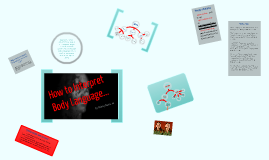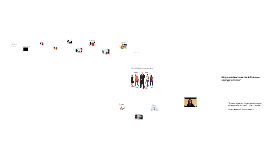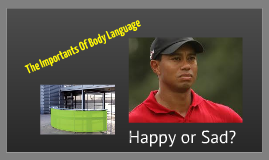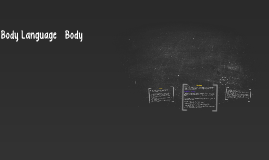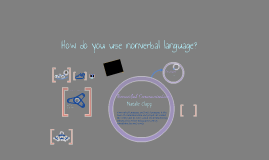Body Language
Transcript: First of all, What is Nonverbal Language? Understanding Nonverbal Communication Concious and intended Body Language Less commonly discussed because it seems unproblematic These are things you WANT people to pick up about you. The words people say outloud are sometimes different than what they *really* mean. Some people mask what they are feeling by lying through body language People unconciously do not believe what they say Others are completely silent, but their body language reveals everything Examples of Voluntary/intentional movements Hand gestures: waving hello, "The finger", blinking with one eye, etc. Tone of voice: The pitch of your voice and the way you communicate. Yelling, speaking softly or whispering, saying things in a sarcastic way, intonation Breathing: Slow or fast breathing, breathing heavily or slowly to relax SO if some hand gestures are a result from culture, does that mean we sometimes use false body language to mask something we are feeling? To better understand others, try to identify the cause of their intentional body movements Consider all the possible reasons for change You will learn much about the person and how they feel in the enviornment they are in. What are these peoples perceptions? Involuntary Body Language Body language and other nonverbal communication devices one cannot control Often speaks volumes about what the person is feeling Unbiased Unable to falsify Your body NEVER lies! Most accurate way to read a persons subconcious Object communication "Greetings, you come here often?" Voluntary Language There are three categories of Nonverbal Language Body In face-to-face conversations, the words we say account for less than 10% in the message we are trying to convey. Voluntary Involuntary Nonverbal languege that can be controlled through practice Non-verbal language and body language is the base of communication and people all around the world and in every social environment may enhance his or her message to convey something beyond words. Clothing in body language form is used to express a certain personality And one more thing... http://www.google.com/imgres?imgurl=http://www.magazine.ucla.edu/exclusives/print/brain-hand-gestures.jpg&imgrefurl=http://magazine.ucla.edu/exclusives/brain-hand-gestures/&usg=__u2j1C30ANdif2SOMuDw3mqaiGTc=&h=340&w=440&sz=21&hl=en&start=2&zoom=1&tbnid=FOdeYlmS5QX3EM:&tbnh=98&tbnw=127&ei=NTAxT4qgBYXJiQKkmvjJAw&prev=/search%3Fq%3Dhand%2Bgestures%26um%3D1%26hl%3Den%26safe%3Dactive%26sa%3DN%26rls%3Dcom.microsoft:*%26tbm%3Disch&um=1&itbs=1 How do you use nonverbal language? What "look" were you going for today? wanted to look professional to give your presentation? wanted to look hawt and sexy for that guy that sits beside you in math? wanted to look normal to blend in? Feeling quirky and wearing something bold? Wanted to look rich? Did you wear your new ugg boots your mommy got you for christmas? Involuntary Body Language Conclusion Different perspectives Examples: A child crying in the middle of the store A child picking their nose or sucking their thumb in public People sometimes unconsciously decide upon outifut with a look they want to percieve. Children are often the only one's who do not care about masking their voluntary body languege Body Things such as tone, pitch, loudness, duration, intonation and tempo, voice quality, speaking style and speech clarity, and accent can all give off nonverbal cues. The clothing choices people make on a given day may reveal their mood or outlook on the day. example: someone wearing certain colors or silhouettes Position of the body relative to other people and things Posture and body position Micro-movement of muscles Speed of walking Sweating hand/arm/leg position and movements smells (eg. pheremones) People use clothing to pertain a certain social status "Children should be seen, not heard" "Must...grab...the presidency..." "How you doin'?" Connections to Romanticism Vocalics is the study of nonverbal cues of the voice Natalie Clapp Most of the time, voluntary body movement takes place in social settings. Body Body magazine.ucla.edu/exclusives/brain-hand-gestures/ Body The most common form of object communication is clothing http://www.simplybodylanguage.com/body-language-pics.html "How your brain responds to a "thumbs up" and other hand gestures depends on who you are and who's doing the gesturing. Culture and ethnicity play a part in whether or not the brain's neurons fire in response to a gesture, say UCLA brain researchers Istvan Molnar-Szakacs and Dr. Marco Iacoboni." Voice What social or economic status does each individual belong to? What about them categorizes them? Includes things like: I think this is about feelings! Does culture influence body language???!? "Good job! You learned something today!" is here Nonverbal Communication Voluntary Body






